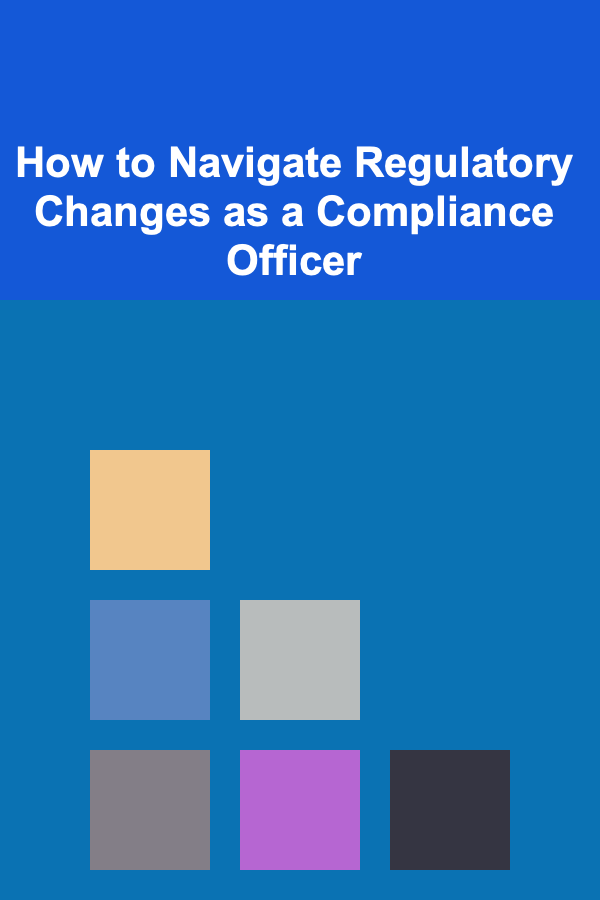
How to Navigate Regulatory Changes as a Compliance Officer
ebook include PDF & Audio bundle (Micro Guide)
$12.99$10.99
Limited Time Offer! Order within the next:

As a compliance officer, one of the most important aspects of your role is ensuring that an organization adheres to the various regulations and laws that govern its operations. Regulatory environments are constantly evolving, with new regulations being introduced, existing rules being updated, and enforcement practices changing. In this context, a compliance officer's ability to stay informed, interpret new regulations, and implement effective compliance strategies is essential. Navigating regulatory changes requires a proactive approach, a keen understanding of the legal landscape, and the ability to adapt quickly.
This article explores how compliance officers can navigate regulatory changes, focusing on strategies for staying ahead of regulatory developments, understanding their impact, and ensuring the organization remains compliant at all times.
The Role of a Compliance Officer
A compliance officer's primary responsibility is to ensure that an organization complies with relevant laws, regulations, and internal policies. This involves:
- Monitoring Compliance: Ensuring that the organization follows internal and external regulations.
- Risk Management: Identifying potential areas of non-compliance and mitigating risks.
- Training and Education: Providing staff with the knowledge and tools they need to adhere to regulatory requirements.
- Reporting: Ensuring accurate and timely reporting to regulatory bodies and senior management.
- Liaising with Regulatory Authorities: Engaging with regulators and ensuring the organization stays up-to-date on regulatory changes.
Compliance officers must also maintain a keen understanding of the ever-changing regulatory landscape, as failure to comply with regulations can lead to significant penalties, legal issues, and damage to an organization's reputation.
Understanding Regulatory Changes
Regulatory changes can come in many forms, such as:
- New Legislation: Laws passed by governmental bodies that create new regulatory requirements.
- Amendments to Existing Laws: Changes to current laws or regulations that modify compliance expectations.
- Court Rulings: Judicial decisions that reinterpret or establish new precedents related to compliance.
- Regulatory Guidance: Directives from regulatory bodies or industry-specific authorities that provide clarification on compliance requirements.
- Industry Standards: Changes in industry best practices or self-regulatory standards that impact compliance.
Compliance officers must stay informed about regulatory changes by monitoring multiple sources of information, including government websites, legal journals, regulatory body announcements, and industry-specific resources.
How to Stay Informed About Regulatory Changes
Staying up-to-date on regulatory changes is crucial to fulfilling your duties as a compliance officer. Below are several strategies to ensure that you are always informed:
1. Monitor Regulatory Websites and Newsletters
Regulatory bodies and government agencies often provide updates through their official websites, publications, and newsletters. Regularly check these sources for announcements regarding changes in regulations.
- Government Websites: In the U.S., websites like the Federal Register or the Securities and Exchange Commission (SEC) offer a wealth of information on new laws and regulatory updates.
- Industry-Specific Authorities: Depending on the industry you operate in, there may be specialized regulators (e.g., Financial Conduct Authority in the UK or Food and Drug Administration in the U.S.) that issue alerts and updates.
- Newsletters: Subscribe to newsletters from law firms, industry groups, and regulatory bodies that cover the latest developments in your field. Many legal and compliance firms publish regular updates on regulatory changes.
2. Engage with Industry Groups and Associations
Industry associations often play a key role in monitoring and disseminating information about regulatory changes. By being an active member of industry groups, you can gain insights into emerging regulatory trends, participate in webinars or seminars, and discuss compliance challenges with peers.
- Conferences and Events: Attend compliance-focused conferences and events to hear directly from experts, regulators, and legal professionals about regulatory changes.
- Networking: Networking with other compliance officers and legal experts can help you stay informed about changes in the regulatory landscape and best practices for navigating them.
3. Build Relationships with Legal Counsel
A close relationship with your organization's legal counsel is invaluable when navigating regulatory changes. Legal professionals can provide expert advice and help interpret the impact of new regulations on your organization's operations. Regularly consulting with legal counsel ensures that you can quickly understand and act on legal changes.
- Internal Legal Teams: Work closely with your organization's internal legal department to stay informed and ensure you have the necessary legal support to interpret and implement regulatory changes.
- External Legal Advisors: If your organization doesn't have an in-house legal team, maintain relationships with external legal advisors who specialize in regulatory compliance.
4. Use Regulatory Technology Tools
Advances in technology have led to the development of regulatory technology (RegTech) tools that can help compliance officers stay informed and manage regulatory changes more effectively. These tools often use artificial intelligence and machine learning to monitor regulatory developments and notify compliance officers about relevant updates.
- Regulatory Monitoring Software: Tools like Ascent, ComplyAdvantage, or Thomson Reuters Regulatory Intelligence use AI to monitor regulations and provide real-time alerts when changes occur.
- Document Management Systems: Use document management systems to organize and track regulatory documents, ensuring you have easy access to relevant information when needed.
Assessing the Impact of Regulatory Changes
Once you are aware of regulatory changes, the next step is to assess their impact on your organization. Some changes may require immediate action, while others might be less urgent. Understanding the potential consequences of a regulatory change is crucial for prioritizing compliance efforts.
1. Conduct a Risk Assessment
Regulatory changes can introduce new risks or affect existing ones. A thorough risk assessment helps to determine the potential impact of a change on your organization's operations, finances, and reputation.
- Identify Areas of Impact: Review the new regulation and determine which departments, processes, or business functions will be affected.
- Evaluate Risks: Assess the severity and likelihood of non-compliance, considering factors such as the complexity of the regulation, enforcement mechanisms, and the organization's readiness to adapt.
- Prioritize Compliance Actions: Based on the risk assessment, prioritize compliance actions to ensure that the most critical areas are addressed first.
2. Consult Stakeholders Across the Organization
Regulatory changes often require input from multiple departments within an organization. For example, new financial regulations may require input from accounting and finance teams, while data protection laws may involve legal, IT, and HR departments.
- Internal Collaboration: Engage with key stakeholders within the organization to understand how the regulatory change will affect their operations and gather insights on potential challenges.
- Cross-Departmental Meetings: Organize meetings with representatives from different departments to discuss the regulatory change and formulate a comprehensive compliance strategy.
3. Stay Focused on Strategic Objectives
While compliance is crucial, it's also important to align your compliance efforts with the organization's broader strategic objectives. When assessing the impact of regulatory changes, consider how they might affect the organization's goals and long-term success.
- Adapt to New Business Realities: Regulatory changes may present new opportunities or challenges for the business. Evaluate how the change fits into the organization's overall strategy and ensure that compliance actions support business objectives.
- Consider Costs and Resources: Implementing compliance measures can involve significant time, effort, and financial resources. Weigh the costs of compliance against potential risks and penalties for non-compliance to determine the most efficient approach.
Implementing Compliance Changes
Once you've assessed the impact of a regulatory change and developed a strategy, the next step is to implement the necessary changes within the organization. This requires effective planning, communication, and training to ensure that everyone involved understands their role in maintaining compliance.
1. Update Policies and Procedures
Regulatory changes often necessitate updates to the organization's internal policies and procedures. Review and revise existing compliance documentation to reflect the new requirements, and ensure that employees are informed of these changes.
- Policy Revisions: Modify internal policies to align with the new regulation. For example, if there is a new data privacy law, update data protection policies to reflect the revised standards.
- Procedure Updates: Revise compliance procedures to ensure that they are consistent with the new regulatory framework. This may involve updating reporting mechanisms, monitoring practices, or training protocols.
2. Provide Training and Awareness Programs
Training employees on new regulations and compliance requirements is essential for ensuring that the organization adheres to legal standards. Tailor training programs to different departments and levels within the organization.
- Targeted Training: Offer specialized training sessions for teams that are most affected by the regulatory change. For example, HR teams may need specific training on employee data protection, while finance teams may need training on new accounting regulations.
- Ongoing Education: Compliance is an ongoing process, and it's essential to offer continuous education to staff to keep them up-to-date with regulatory changes.
3. Monitor and Audit Compliance
After implementing the necessary changes, it's important to continuously monitor and audit compliance efforts to ensure that the organization remains in adherence to the new regulations.
- Internal Audits: Conduct regular internal audits to verify that compliance measures are being followed and identify any gaps or potential issues.
- Continuous Monitoring: Use automated tools and dashboards to track compliance status in real-time and ensure that the organization remains compliant.
Conclusion
Navigating regulatory changes as a compliance officer is a dynamic and challenging task that requires vigilance, adaptability, and strategic thinking. By staying informed about regulatory developments, assessing their impact, and implementing the necessary changes, compliance officers can ensure that their organizations remain compliant with the law and avoid legal and reputational risks.
As regulatory landscapes continue to evolve, compliance officers must remain proactive, continuously adapting to new challenges and finding innovative ways to maintain compliance. With the right tools, knowledge, and collaboration, compliance officers can effectively guide their organizations through the complexities of regulatory changes, ensuring long-term success and stability.
Reading More From Our Other Websites
- [Home Pet Care 101] How to Train Your Dog to Stop Barking at the Doorbell and Other Common Triggers
- [Home Budget 101] How to Budget for Home Improvement Projects in a Step-by-Step Plan
- [Home Maintenance 101] How to Maintain Your Home's Water Pressure for Consistent Performance
- [Home Lighting 101] How to Light a Staircase for Safety and Style
- [Home Lighting 101] How to Layer Your Lighting for a Cozy Ambience
- [Personal Finance Management 101] How to Choose the Right Savings Account for Your Needs
- [Home Party Planning 101] How to Make Your Home Party More Interactive with DIY Activities
- [Organization Tip 101] How to Set Up a Display Case for Fragile Antiques
- [Toy Making Tip 101] Step-by-Step Guide to Crafting Wooden Toys for a One-of-a-Kind Gift
- [Survival Kit 101] Best Survival Kit for College Students Living in Dormitories During Campus Emergencies

How to Soundproof Your Home for a Peaceful Meditation Space
Read More
How to Soundproof Your Home for Music Practice or Recording Studios
Read More
Navigating Virtual Career Fairs: Tips for Success
Read More
What Tips Can Help You Organize Your Travel Gear?
Read More
How To Start a Mobile Car Wash Business: A Comprehensive Guide
Read More10 Ways to Maximize Your Expense Tracking for Job Search Success
Read MoreOther Products

How to Soundproof Your Home for a Peaceful Meditation Space
Read More
How to Soundproof Your Home for Music Practice or Recording Studios
Read More
Navigating Virtual Career Fairs: Tips for Success
Read More
What Tips Can Help You Organize Your Travel Gear?
Read More